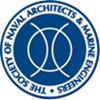楔形入水松散双向耦合水弹性模型的验证研究
IF 1
4区 工程技术
Q3 ENGINEERING, CIVIL
引用次数: 1
摘要
结构响应和水动力载荷(水弹性)之间的相互作用必须考虑到由复合材料制成的高速滑行艇的设计和操作目的,这些复合材料容易受到频繁的水冲击(砰击)。提出了一种研究柔性楔水弹性砰击的计算方法。计算方法是基于Wagner的流体动力学解和线性有限元板模型之间的松散双向耦合。对该耦合模型进行了验证和确认(V&V)。研究发现,该模型高估了刚体/喷根运动学<15%,高估了水动力载荷/结构响应<26%。高速飞行器运行包络线的主要约束条件之一是砰击(水冲击)。当船体的一部分/全部离开水面,然后以足够高的速度重新进入水面时,船体和水面之间会发生撞击(Lloyd 1989;Faltinsen 2005)。频繁的水冲击,其作用类似于“水锤”,以及其诱导的加速度,对船体结构、船员和船上仪器构成了极大的危险(Yamamoto等人,1985;Ensign等人,2000;Hirdaris等人,2014)。随着轻质材料的日益使用,结构变形和水动力载荷(水弹性)之间的相互作用变得更加普遍。由于对这种复杂现象缺乏了解,目前高速船的设计标准基于经验程序,而不考虑水弹性(DNV 2013;ABS 2016)。因此,更好地理解水弹性砰击是设计更高性能飞行器的第一步(Fu等人,2014;Judge等人2020)。本文章由计算机程序翻译,如有差异,请以英文原文为准。
A Verification and Validation Study on a Loosely Two-Way Coupled Hydroelastic Model of Wedge Water Entry
The interaction between the structural response and hydrodynamic loading (hydroelasticity) must be considered for design and operation purposes of high-speed planing craft made of composites that are prone to frequent water impact (slamming). A computational approach was proposed to study the hydroelastic slamming of a flexible wedge. The computational approach is a loose two-way coupling between a Wagner-based hydrodynamic solution and a linear finite element plate model. Verification and validation (V&V) was performed on this coupled model. It was found that the model overpredicts rigid-body/spray root kinematics by <15% and hydrodynamic loading/ structural response by <26%.
One of the primary constraints on the operational envelope of high-speed craft is slamming (water impact). Slamming occurs between the hull body and the water surface when a portion/whole of the craft exits the water and then reenters at high-enough velocity (Lloyd 1989; Faltinsen 2005). The frequent water impacts, which work like “water hammers,” along with their induced acceleration pose great jeopardy on hull structures as well as crew and instrument on-board (Yamamoto et al. 1985; Ensign et al. 2000; Hirdaris et al. 2014). With the growing use of lightweight materials, the interaction between the structural deformation and the hydrodynamic loading (hydroelasticity) becomes more prevalent. The current design criteria of high-speed craft are based on empirical procedures with no regard to hydroelasticity due to the lack of understanding of this complex phenomenon (DNV 2013; ABS 2016). Therefore, a better comprehension of hydroelastic slamming is the first step to designing more high-performance craft (Fu et al. 2014; Judge et al. 2020).
求助全文
通过发布文献求助,成功后即可免费获取论文全文。
去求助
来源期刊

Journal of Ship Research
工程技术-工程:海洋
CiteScore
2.80
自引率
0.00%
发文量
12
审稿时长
6 months
期刊介绍:
Original and Timely technical papers addressing problems of shipyard techniques and production of merchant and naval ships appear in this quarterly publication. Since its inception, the Journal of Ship Production and Design (formerly the Journal of Ship Production) has been a forum for peer-reviewed, professionally edited papers from academic and industry sources. As such, it has influenced the worldwide development of ship production engineering as a fully qualified professional discipline. The expanded scope seeks papers in additional areas, specifically ship design, including design for production, plus other marine technology topics, such as ship operations, shipping economic, and safety. Each issue contains a well-rounded selection of technical papers relevant to marine professionals.
 求助内容:
求助内容: 应助结果提醒方式:
应助结果提醒方式:


